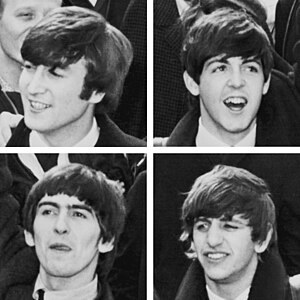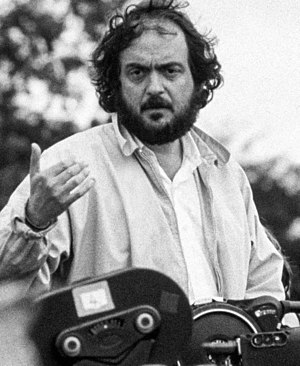Portal:1960s
Portal maintenance status: (May 2019)
|
|
Template:/box-header
This is a Featured article, which represents some of the best content on English Wikipedia..
The Beatles were an English rock band formed in Liverpool in 1960. The core lineup of the band comprised John Lennon, Paul McCartney, George Harrison and Ringo Starr. They are widely regarded as the most influential band of all time and were integral to the development of 1960s counterculture and the recognition of popular music as an art form. Rooted in skiffle, beat and 1950s rock 'n' roll, their sound incorporated elements of classical music and traditional pop in innovative ways. The band also explored music styles ranging from folk and Indian music to psychedelia and hard rock. As pioneers in recording, songwriting and artistic presentation, the Beatles revolutionized many aspects of the music industry and were often publicized as leaders of the era's youth and sociocultural movements. Led by primary songwriters Lennon and McCartney, the Beatles evolved from Lennon's previous group, the Quarrymen, and built their reputation by playing clubs in Liverpool and Hamburg, Germany, over three years from 1960, initially with Stuart Sutcliffe playing bass. The core trio of Lennon, McCartney and Harrison, together since 1958, went through a succession of drummers, including Pete Best, before inviting Starr to join them in 1962. Manager Brian Epstein moulded them into a professional act, and producer George Martin guided and developed their recordings, greatly expanding their domestic success after they signed with EMI Records and achieved their first hit, "Love Me Do", in late 1962. As their popularity grew into the intense fan frenzy dubbed "Beatlemania", the band acquired the nickname "the Fab Four". Epstein, Martin or other members of the band's entourage were sometimes informally referred to as a "fifth Beatle". (Full article...) This is a Good article, an article that meets a core set of high editorial standards.
Abbey Road is the eleventh studio album by the English rock band the Beatles, released on 26 September 1969, by Apple Records. It is the last album the group recorded, although Let It Be (1970) was the last album completed before the band's break-up in April 1970. It was mostly recorded in April, July, and August 1969, and topped the record charts in both the United States and the United Kingdom. A double A-side single from the album, "Something" / "Come Together", was released in October, which also topped the charts in the US. Abbey Road incorporates styles such as rock, pop, blues, and progressive rock, and makes prominent use of the Moog synthesiser and guitar played through a Leslie speaker unit. It is also notable for having a long medley of songs on side two that have subsequently been covered as one suite by other notable artists. The album was recorded in a more collegial atmosphere than the Get Back / Let It Be sessions earlier in the year, but there were still significant confrontations within the band, particularly over Paul McCartney's song "Maxwell's Silver Hammer", and John Lennon did not perform on several tracks. By the time the album was released, Lennon had left the group, though this was not publicly announced until McCartney also quit the following year. (Full article...) Template:/box-header The page "Portal:1960s/Featured picture/5" does not exist. Template:/box-header The page "Portal:1960s/DYK/1" does not exist. Template:/box-header Lua error in mw.title.lua at line 346: bad argument #2 to 'title.new' (unrecognized namespace name 'Portal'). Template:/box-header
This is a Featured article, which represents some of the best content on English Wikipedia..
John Herschel Glenn Jr. (July 18, 1921 – December 8, 2016) was an American Marine Corps aviator, astronaut, businessman, and politician. He was the third American in space and the first American to orbit the Earth, circling it three times in 1962. Following his retirement from NASA, he served from 1974 to 1999 as a U.S. Senator from Ohio; in 1998, he flew into space again at the age of 77. Before joining NASA, Glenn was a distinguished fighter pilot in World War II, the Chinese Civil War, and the Korean War. He shot down three MiG-15s and was awarded six Distinguished Flying Crosses and eighteen Air Medals. In 1957, he made the first supersonic transcontinental flight across the United States. His on-board camera took the first continuous, panoramic photograph of the United States. (Full article...) This is a Good article, an article that meets a core set of high editorial standards.
Stanley Kubrick (/ˈkuːbrɪk/; July 26, 1928 – March 7, 1999) was an American film director, screenwriter, producer, and photographer. Widely considered one of the greatest filmmakers of all time, his films were nearly all adaptations of novels or short stories, spanning a number of genres and gaining recognition for their intense attention to detail, innovative cinematography, extensive set design, and dark humor. Born and raised in New York City, Kubrick was an average school student but displayed a keen interest in literature, photography, and film from a young age; he began to teach himself all aspects of film producing and directing after graduating from high school. After working as a photographer for Look magazine in the late 1940s and early 1950s, he began making low-budget short films and made his first major Hollywood film, The Killing, for United Artists in 1956. This was followed by two collaborations with Kirk Douglas: the anti-war film Paths of Glory (1957) and the historical epic film Spartacus (1960). (Full article...)
The counterculture of the 1960s was an anti-establishment cultural phenomenon and political movement that developed in the Western world during the mid-20th century. It began in the early 1960s, and continued through the early 1970s. It is often synonymous with cultural liberalism and with the various social changes of the decade. The effects of the movement have been ongoing to the present day. The aggregate movement gained momentum as the civil rights movement in the United States had made significant progress, such as the Voting Rights Act of 1965, and with the intensification of the Vietnam War that same year, it became revolutionary to some. As the movement progressed, widespread social tensions also developed concerning other issues, and tended to flow along generational lines regarding respect for the individual, human sexuality, women's rights, traditional modes of authority, rights of people of color, end of racial segregation, experimentation with psychoactive drugs, and differing interpretations of the American Dream. Many key movements related to these issues were born or advanced within the counterculture of the 1960s. As the era unfolded, what emerged were new cultural forms and a dynamic subculture that celebrated experimentation, individuality, modern incarnations of Bohemianism, and the rise of the hippie and other alternative lifestyles. This embrace of experimentation is particularly notable in the works of popular musical acts such as the Beatles, Jimi Hendrix, Jim Morrison, Janis Joplin and Bob Dylan, as well as of New Hollywood, French New Wave, and Japanese New Wave filmmakers, whose works became far less restricted by censorship. Within and across many disciplines, many other creative artists, authors, and thinkers helped define the counterculture movement. Everyday fashion experienced a decline of the suit and especially of the wearing of hats; other changes included the normalisation of long hair worn down for women (as well as many men at the time), the popularization of traditional African, Indian and Middle Eastern styles of dress (including the wearing of natural hair for those of African descent), the invention and popularization of the miniskirt which raised hemlines above the knees, as well as the development of distinguished, youth-led fashion subcultures. Styles based around jeans, for both men and women, became an important fashion movement that has continued up to the present day. (Full article...) Lua error in Module:Selected_recent_additions at line 69: bad argument #1 to 'gmatch' (string expected, got nil).
The following Wikimedia Foundation sister projects provide more on this subject:
Discover Wikipedia using portals |



























